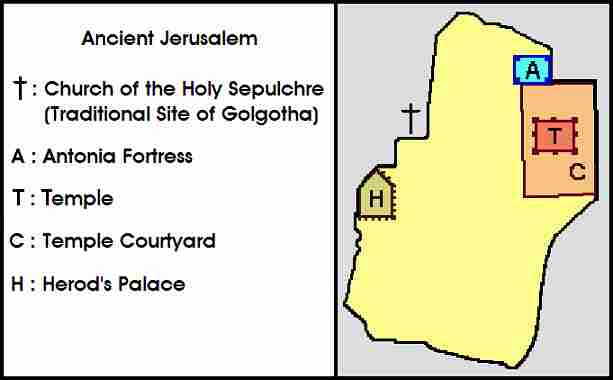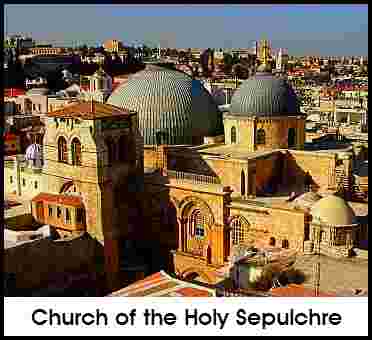
Golgotha
Golgotha is the biblical name for the place where Jesus was crucified. It was probably a small hill just outside the walls of ancient Jerusalem. According to Christian tradition, it was within the area now occupied by the Church of the Holy Sepulchre. But some biblical scholars doubt that this is the correct location.
The name "Golgotha" is derived from the Aramaic word gulgulta. Matthew 27:33 and Mark 15:22 give its meaning as "place of the skull." When Saint Jerome translated these verses into Latin, he used the Latin word for skull, calvaria, which was later converted into the English word Calvary.
The gospels don't say why Golgotha was called the "place of the skull". One common suggestion is that the site was on a hill or near a rock that had the shape of a skull. Another suggestion, first made by the third-century scholar Origen, is that the name referred to the burial place of Adam's skull, traditionally believed to have been interred at Jerusalem. But these are just suggestions, and no one really knows how the site got its name.
The bible also doesn't say where Golgotha was located. But it does give three specific clues:
Clue 1. John 19:41-42 says that Jesus' body was carried only a short distance before it was placed in the tomb. This indicates that the site was probably near a cemetery.
Clue 2. Hebrews 13:12 says that the site was "outside the city gate", but unfortunately doesn't say which gate.
Clue 3. Matthew 27:39 indicates that the location was near a road which carried a lot of foot traffic.
The second clue is consistent with a traditional Jewish religious requirement that all executions had to take place outside the city, a requirement which the Romans appear to have generally honored. And the third clue is consistent with the fact that the Romans often crucified people on elevated spots near major roads, to serve as a warning of the probable fate of anyone who challenged their authority.
Some scholars have suggested that Golgotha was probably near the northern section of the city, because this would put it close to the administrative area, where the main public buildings were located. At the time of the crucifixion, the northern section of the city was bounded by the so-called Second Wall. Unfortunately Jerusalem was destroyed twice by the Roman army during Jewish revolts in the first and second centuries, and this makes it difficult to determine the exact boundaries of the ancient city. However, the approximate location of the Second Wall is known.
During the first destruction of Jerusalem, most Christians fled the city, and the second destruction dispersed almost the entire population. Because of these upheavals, and because Christian writers rarely mentioned Golgotha during the next two centuries, some scholars think that knowledge of its location was probably lost. But other scholars argue that local traditions could have been strong enough to preserve the knowledge despite the upheavals. The scarcity of reliable information from these early centuries makes it impossible to know for sure.
Better information is available in writings from the fourth century onward, starting from the time of Constantine the Great. During his reign he and his mother, Empress Helena, became interested in building a church near the locations of Golgotha and the tomb in which Jesus was placed. The idea was especially appealing to the Empress, and in 326 AD she made a trip to Jerusalem to explore the possibilities.
Note: The map shows the traditional site of Golgotha as identified by Empress Helena. The Church of the Holy Sepulchre was built on this site.
When the Empress reached Jerusalem, she was told that Golgotha and the tomb were in the vicinity of an old Jewish cemetery located on the northwest side of the city. The original source of this information is uncertain. One story, found in a fifth-century book called the Acts of Judas Cyriacus, says that Christians had learned about the cemetery from an old Jew who had to be tortured before he would reveal its location. But many scholars doubt this story, and in fact there is a good possibility that the cemetery was well-known to the people of the city. It's also possible that local traditions associated the cemetery with past crucifixions, thereby making it an obvious choice for the site of Golgotha.
In any case, the Empress was told that Golgotha and the tomb were in the vicinity of this old Jewish cemetery. But the exact locations of the two sites were still unknown. One problem was that the Romans had built a pagan temple over part of the cemetery, and in the process they probably destroyed parts of it.
Shortly after her arrival, the Empress ordered the demolition of the pagan temple and the excavation of the area beneath it. The earliest account of this excavation, by the church historian Eusebius, simply says "the venerable and hallowed monument of Our Lord's resurrection became visible." Exactly what this means isn't clear, but some later accounts say that the excavation uncovered a tomb containing some nails and the sign that Pilate had attached to the top of the cross. Several later accounts also say that three crosses were found, either in the tomb or a nearby cistern, and that one of them was identified by its healing powers as the true cross.
Because the earliest writer Eusebius doesn't mention the nails, the crosses, or Pilate's sign, some scholars think that the later accounts were embellished, especially since they differ from each other in various details. Thus, there is some uncertainty about what was actually found during the excavation.
The first churches built at the location were later destroyed, once by Persian invaders, and once by Arabs. After the Crusaders gained control of Jerusalem in the eleventh century, they constructed the present Church of the Holy Sepulchre, although part of it had to be rebuilt after it was damaged by a fire in 1808. It encloses both the tomb of Jesus and a small rocky outcrop called the "rock of Golgotha".
According to church tradition, Jesus began his walk to Calvary from the Antonia Fortress, which housed the main Roman military garrison in the city. The traditional route, called the Via Dolorosa, covers a distance of about 0.4 mile [650 meters] and ends at the church. However, some scholars think that the last interrogation of Jesus took place at Herod's Palace, and that he began the walk from there. This would be a shorter distance.
The site of the present church appears to fit the available evidence regarding Golgotha's location: The church is northwest of the ancient city, probably just outside the ancient wall, and apparently in the area of an old cemetery. Thus it may very well mark the correct location, or at least be near it. But some scholars have expressed doubts, and several other possible sites have been proposed. The best-known alternate location, Gordon's Calvary (the Garden Tomb), is about 0.4 mile north of the ancient city.



